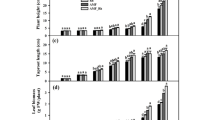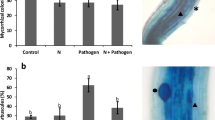Abstract
Soybean plants can form tripartite symbiotic associations with rhizobia and arbuscular mycorrhizal (AM) fungi, but little is known about effects of co-inoculation with rhizobia and AM fungi on plant growth, or their relationships to root architecture as well as nitrogen (N) and phosphorus (P) availability. In the present study, two soybean genotypes contrasting in root architecture were grown in a field experiment to evaluate relationships among soybean root architecture, AMF colonization, and nodulation under natural conditions. Additionally, a soil pot experiment in greenhouse was conducted to investigate the effects of co-inoculation with rhizobia and AM fungi on soybean growth, and uptake of N and P. Our results indicated that there was a complementary relationship between root architecture and AMF colonization in the field. The deep root soybean genotype had greater AMF colonization at low P, but better nodulation with high P supply than the shallow root genotype. A synergistic relationship dependent on N and P status exists between rhizobia and AM fungi on soybean growth. Co-inoculation with rhizobia and AM fungi significantly increased soybean growth under low P and/or low N conditions as indicated by increased shoot dry weight, along with plant N and P content. There were no significant effects of inoculation under adequate N and P conditions. Furthermore, the effects of co-inoculation were related to root architecture. The deep root genotype, HN112, benefited more from co-inoculation than the shallow root genotype, HN89. Our results elucidate new insights into the relationship between rhizobia, AM fungi, and plant growth under limitation of multiple nutrients, and thereby provides a theoretical basis for application of co-inoculation in field-grown soybean.




Similar content being viewed by others
References
Adesemoye AO, Kloeppe JW (2009) Plant-microbes interactions in enhanced fertilizer-use efficiency. Appl Microbiol Biotechnol 85:1–12
Ao J, Fu J, Tian J, Yan X, Liao H (2010) Genetic variability for root morph-architecture traits and root growth dynamics as related to phosphorus efficiency in soybean. Func Plant Biol 37:304–312
Barea JM, Azcon-Aguilar C (1983) Mycorrhizas and their significance in nodulation, nitrogen fixing plants. Adv Agron 36:1–54
Berta G, Fusconi A, Trotta A, Scannerini S (1990) Morphogenetic modifications induced by the mycorrhizal fungus Glomus strain E3 in the root system of Allium porrum L. New Phytol 114:207–215
Bethlenfalvay GJ, Brown MS, Stafford AE (1985) The Glycine-Glomus-Rhizobium symbiosis II. Antagonistic effects between mycorrhizal colonization and nodulation. Plant Physiol 79:1054–1058
Blilou J, Ocampo J, Garcia-Garrido J (1999) Resistance of pea roots to endomycorrhiza fungus or Rhizobium correlates with enhanced levels of endogenous salicylic acid. J Exp Bot 50:1663–1668
Bohlool BB, Ladha JK, Garrity DP, George T (1992) Biological N fixation for sustainable agriculture: a perspective. Plant Soil 141:1–11
Bolan NS (1991) A critical review on the role of mycorrhizal fungi in the uptake of phosphorus by plants. Plant Soil 134:187–207
Cao GQ (2007) Screening of effective rhizobial strains for soybean and characterization of their biological nitrogen fixation efficiency on acid red soils. Master dissertation, South China Agricultural University
Cheng F, Cao G, Wang X, Zhao J, Yan X, Liao H (2009) Identification and application of effective rhizobial strains for soybean on acid laterite soils in South China. Chinese Sci Bull 54:412–420
Cluett HC, Boucher DH (1983) Indirect mutualism in the legume Rhizobium-mycorrhizal fungus interaction. Oecologia 59:405–408
Cruz C, Green JJ, Watson GC, Wilson F, Martins-Loução MA (2004) Functional aspects of root architecture and mycorrhizal inoculation with respect to nutrient uptake capacity. Mycorrhiza 14:177–184
FAO (Food and Agriculture Organization) (2003) http://apps.fao.org
Fitter AH (2006) What is the link between carbon and phosphorus fluxes in arbuscular mycorrhizas? A null hypothesis for symbiotic function. New Phytol 172:3–6
Garnett T, Conn V, Kaiser B (2009) Root based approaches to improving nitrogen use efficiency in plants. Plant Cell Environ 32:1272–1283
Graham PH, Vance CP (2000) Nitrogen fixation in perspective: an overview of research and extension needs. Field Crop Res 65:93–106
Graham PH, Viteri SE, Mackie F, Vargas AT, Palacios A (1982) Variation in acid soil tolerance among strains of Rhizobium phaseoli. Field Crop Res 5:121–128
Hardarson G, Atkins C (2003) Optimising biological N2 fixation by legumes in farming systems. Plant Soil 252:41–54
Harris D, Pacovsky RS, Paul EA (1985) Carbon economy of soybean-Rhizobium-Glomus associations. New Phytol 101:427–440
Hodge A, Berta G, Doussan C, Merchan F, Crespi M (2009) Plant root growth, architecture and function. Plant Soil 321:153–187
Huang HC (2007) Studies on mycorrhizae and AMF diversity of plant communities on Nankunshan and Tonggufeng of Guangdong province. Doctoral dissertation, South China Agricultural University
Jakobsen I (1995) Transport of phosphorus and carbon in VA mycorrhizas. In: Varma A, Hock B (eds) Mycorrhiza: structure, function, molecular biology and biotechnology. Springer-Verlag, Berlin, pp 297–324
Kuang R, Liao H, Yan X, Dong Y (2005) Phosphorus and nitrogen interactions in field-grown soybean as related to genetic attributes of root morphological and nodular traits. J Integr Plant Biol 47:549–559
Li SM, Li L, Zhang FS (2004) Enhancing phosphorus and nitrogen uptake of faba bean by inoculating arbuscular mycorrhizal fungus and Rhizobium leguminosarum. J China Agri Uni 9:11–15
Li YY, Yu CB, Cheng X, Li CJ, Sun JH, Zhang FS, Lambers H, Li L (2009) Intercropping alleviates the inhibitory effect of N fertilization on nodulation and symbiotic N2 fixation of faba bean. Plant Soil 323:295–308
Liao H, Yan X, Rubio G, Beebe S, Blair M, Lynch JP (2004) Genetic mapping of basal root gravitropism and phosphorus acquisition efficiency in common bean. Funct Plant Biol 31:959–970
Lisette J, Xavier C, Germida JJ (2003) Selective interactions between arbuscular mycorrhizal fungi and Rhizobium leguminosarum bv. viceae enhance pea yield and nutrition. Biol Fertil Soils 37:261–267
Liu L, Liao H, Wang X, Yan X (2008) Regulation effect of soil P availability on mycorrhizal infection in relation to root architecture and P efficiency of Glycine max. Chinese J Appl Ecol 19:564–568
Lynch JP (1998) The role of nutrient-efficient crops in modern agriculture. J Crop Prod 1:241–264
Marschner H (1995) Mineral nutrition of higher plant, 2nd edn. Academic, New York, p 889
Marshchner H, Dell B (1994) Nutrient uptake in mycorrhizal symbiosis. Plant Soil 159:89–102
Mortimer PE, Pérez-Fernández MA, Valentine AJ (2008) The role of arbuscular mycorrhizal colonization in the carbon and nutrient economy of the tripartite symbiosis with nodulated Phaseolus vulgaris. Soil Biol Biochem 40:1019–1027
Oláh B, Brière C, Bécard G, Dénarié J, Gough C (2005) Nod factors and a diffusible factor from arbuscular mycorrhizal fungi stimulate lateral root formation in Medicago truncatula via the DMI1/DMI2 signalling pathway. Plant J 44:195–207
Pacovsky RS (1986) Micronutrient uptake and distribution in mycorrhizal and phosphorus fertilized soybeans. Plant Soil 95:379–385
Raghothama KG (1999) Phosphate acquisition. Annu Rev Plant Biol 50:665–693
Salvagiotti F, Specht JE, Cassman KG, Walters DT, Weiss A, Dobermann A (2009) Growth and nitrogen fixation in high-yielding soybean: impact of nitrogen fertilization. Agron J 101:958–970
Saxena AK, Rathi SK, Tilak KVBR (1997) Differential effect of various endomycorrhizal fungi on nodulating ability of green gram by Bradyrhizobium sp. (Vigna) strain S24. Biol Fert Soils 24:175–178
Schellenbaum L, Berta G, Ravolanirina F, Tisserant B, Gianinazzi S, Fitter AH (1991) Influence of endomycorrhizal infection on root morphology in a micropropagated woody plant species (Vitis vinifera L.). Ann Bot (Lond) 67:135–141
Smith SE (2002) Soil microbes and plants—raising interest, mutual gains. New Phytol 156:142–144
Smith SE, Read DJ (1997) Mycorrhizal symbiosis. Academic, San Diego, p 605
Smith FA, Grace EJ, Smith SE (2009) More than a carbon economy: nutrient trade and ecological sustainability in facultative arbuscular mycorrhizal symbioses. New Phytol 182:347–358
Tang J, Mborehal I, She L, Liao H, Chen H, Sun Z, Yan X (2005) Nutritional effects of soybean root architecture in a soybean/maize intercropping system. Sci Agri Sin 38:1196–1203
Tilman D, Cassman KG, Matson PA, Naylor R, Polasky S (2002) Agricultural sustainability and intensive production practices. Nature 418:671–677
Vance CP (1997) Enhanced agricultural sustainability through biological nitrogen fixation. In: Legocki A, Bothe H, Puhle A (eds) Biological fixation of nitrogen for ecology and sustainable agriculture. Springer, Berlin, pp 179–186
Vance CP, Uhde-stone C, Allan DL (2003) Phosphorus acquisition and use: critical adaptations by plants for securing a nonrenewable resource. New Phytol 157:423–447
Vierheilig H, Coughlan AP, Wyss U, Piché Y (1998) Ink and vinegar, a simple staining technique for arbuscular-mycorrhizal fungi. Appl Environ Microb 64:5004–5007
Wang X, Wang Y, Tian J, Lim B, Yan X, Liao H (2009) Overexpressing AtPAP15 enhances phosphorus efficiency in soybean. Plant Physiol 151:233–240
Xie Z, Staehelin C, Vierheili H, Wiemken A, Jabbouri S, Broughton WJ, Vogeli-Lange R, Boller T, Xie ZP (1995) Rhizobial nodulation factors stimulate mycorrhizal colonization of undulating and non-nodulating soybeans. Plant Physiol 108:1519–1525
Yao Q, Wang L, Zhu H, Chen J (2009) Effect of arbuscular mycorrhizal fungal inoculation on root system architecture of trifoliate orange (Poncirus trifoliata L. Raf.) seedlings. Sci Hortic 121:458–461
Zhao J, Fu J, Liao H, He Y, Nian H, Hu Y, Qiu L, Dong Y, Yan X (2004) Characterization of root architecture in an applied core collection for phosphorus efficiency of soybean germplasm. Chinese Sci Bull 49:1611–1620
Acknowledgments
This research was in part financially supported by grants from the National Natural Science Foundation of China (Grant no. 30890132) and the National Key Basic Research Special Funds of China (Grant no. 2005CB120902). We are grateful to Dr. Xiaolin Li for the generous gift of mycorrhizal fungus Glomus mosseae, Dr. Tom Walk and Mr. Larry York for English writing. The authors would also like to thank Dr. Andrew Smith for the technical assistance in the AM work and valuable and critical comments on an earlier version of this manuscript.
Author information
Authors and Affiliations
Corresponding author
Rights and permissions
About this article
Cite this article
Wang, X., Pan, Q., Chen, F. et al. Effects of co-inoculation with arbuscular mycorrhizal fungi and rhizobia on soybean growth as related to root architecture and availability of N and P. Mycorrhiza 21, 173–181 (2011). https://doi.org/10.1007/s00572-010-0319-1
Received:
Accepted:
Published:
Issue Date:
DOI: https://doi.org/10.1007/s00572-010-0319-1




